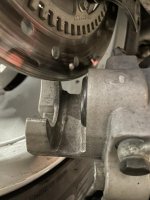Yep, that's all you do. The manual and some videos talk about using a small C clamp - while the old pads are still in there to do the compressing on. But using a large, bladed screw driver in between the old pads to wedge them apart works just as well and is less awkward to use. And that's how you compress the front calipers, anyway. One thing to remember, you'll need to remove the parking brake pulley, and then be sure to turn the parking brake shaft fully CCW. It won't fall out. If it's not backed off fully, then the piston can't retract far enough.
When you put the parking brake pulley and cable all back together, have that right side panel off so that you can watch the front parking brake pulley and cable as you test the brake. When you disengage the parking brake, the front pulley will always rotate CCW until it actuates that micro switch. When the parking brake is disengaged you don't want a slack cable. Otherwise, you get a big bow at the front pulley and the end can pop out. So, you're adjusting the parking brake cable with those two nuts on the bracket in the back, so that when the parking brake is disengaged, there is still spring tension on the cable coming from the rear pulley. If the cable is slack and bowed, adjust the nuts to tighten the cable until the rear pulley just begins to turn. That’s how you keep the spring tension on the cable. Check that the brake doesn’t drag.
When engaging the parking brake, the front pulley rotates CW until the brake engages and the cable gets tight. It then turns itself off. It doesn't operate the switch. If you run out of cable adjustment with the two nuts, you remove the rear pulley and rotate it to another spline on the shaft. If you mark the pulley and the shaft before you remove it, then you can put the pulley back onto the same splines that it was. You never make brake or cable adjustments with the front pulley, only the rear. You may want to observe how the parking brake system operates before you disassemble the rear pulley.
There's a tab that sticks out the back of the rear parking brake pulley. You'll see that it acts as a backstop for rotation as the brake is disengaged. You want a small air gap between that tab and the bracket it goes up against when disengaged. And of course, don't forget to hook the spring as you put the pulley back on the splines.
It'll all be less complicated once you get into it. It sounds worse than it is.

